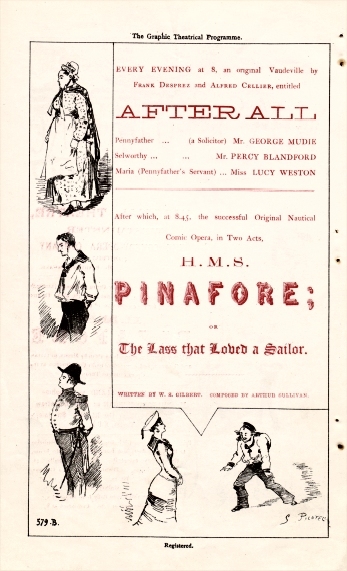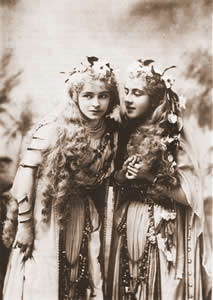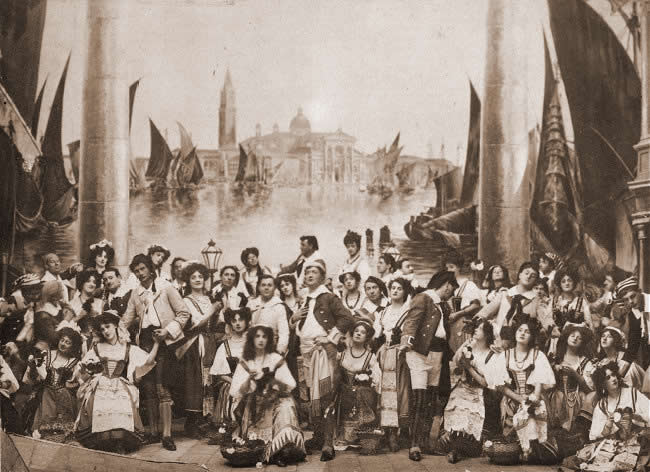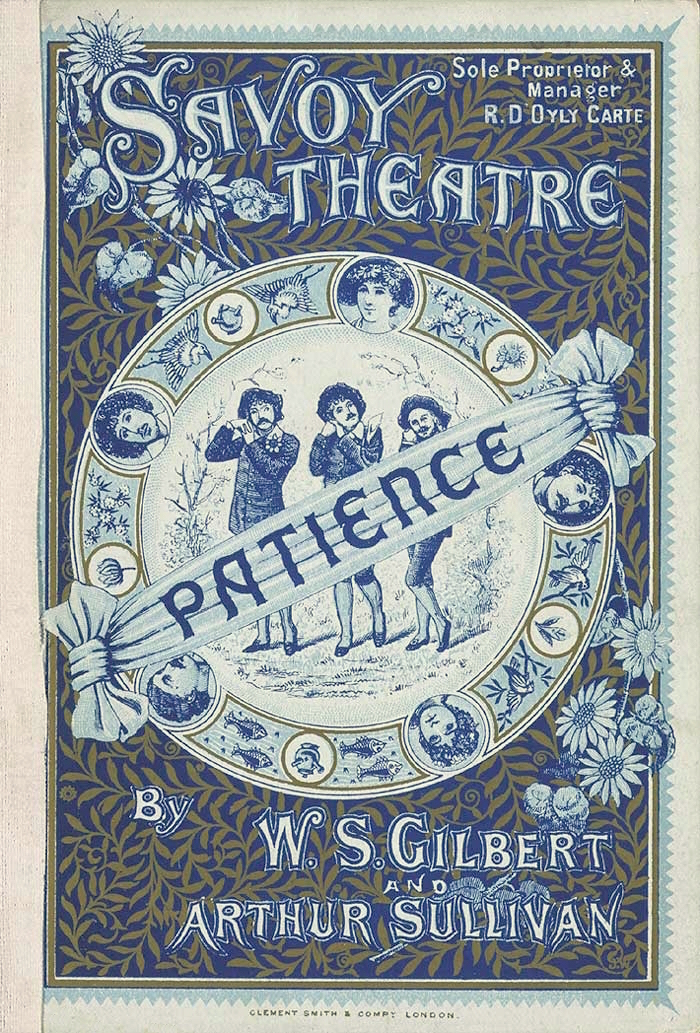|
Emmie Owen
Emily Owen (November 28, 1871 – October 18, 1905) was an English opera singer and actress, best known for her performances in soprano roles of the Savoy Operas with the D'Oyly Carte Opera Company. Beginning as a child actress, she performed for two decades before falling ill on tour and dying at age 33. Early life and career Owen was born in Bristol, where she made her theatrical debut at the Prince's Theatre at the age of eleven. In 1891, Owen joined the D'Oyly Carte Opera Company on tour, playing the small role of Cheetah in ''The Nautch Girl''. She left the company to appear in a Christmas pantomime in Birmingham, returning to tour with the company in 1892 as Cynthia in ''The Vicar of Bray'' and as Polly in the companion piece, ''Captain Billy''. Late in the tour, she played Nance in Arthur Sullivan's ''Haddon Hall''. In 1893, she continued to play Nance at the Savoy Theatre. She then created the parts of Rose in ''Jane Annie'' (1893, and on tour), Princess Nekaya i ... [...More Info...] [...Related Items...] OR: [Wikipedia] [Google] [Baidu] |
Gilbert And Sullivan
Gilbert and Sullivan was a Victorian era, Victorian-era theatrical partnership of the dramatist W. S. Gilbert (1836–1911) and the composer Arthur Sullivan (1842–1900), who jointly created fourteen comic operas between 1871 and 1896, of which ''H.M.S. Pinafore'', ''The Pirates of Penzance'' and ''The Mikado'' are among the best known.Davis, Peter G''Smooth Sailing'' ''New York'' magazine, 21 January 2002, accessed 6 November 2007 Gilbert, who wrote the libretti for these operas, created fanciful "topsy-turvy" worlds where each absurdity is taken to its logical conclusion; fairies rub elbows with British lords, flirting is a capital offence, gondoliers ascend to the monarchy, and pirates emerge as noblemen who have gone astray.Mike Leigh, Leigh, Mike"True anarchists" ''The Guardian'', 4 November 2007, accessed 6 November 2007 Sullivan, six years Gilbert's junior, composed the music, contributing memorable melodies that could convey both humour and pathos. Their operas have enj ... [...More Info...] [...Related Items...] OR: [Wikipedia] [Google] [Baidu] |
Musical Comedy
Musical theatre is a form of theatrical performance that combines songs, spoken dialogue, acting and dance. The story and emotional content of a musical – humor, pathos, love, anger – are communicated through words, music, movement and technical aspects of the entertainment as an integrated whole. Although musical theatre overlaps with other theatrical forms like opera and dance, it may be distinguished by the equal importance given to the music as compared with the dialogue, movement and other elements. Since the early 20th century, musical theatre stage works have generally been called, simply, musicals. Although music has been a part of dramatic presentations since ancient times, modern Western musical theatre emerged during the 19th century, with many structural elements established by the works of Gilbert and Sullivan in Britain and those of Harrigan and Hart in America. These were followed by the numerous Edwardian musical comedies and the musical theatre w ... [...More Info...] [...Related Items...] OR: [Wikipedia] [Google] [Baidu] |
Weather Or No
''Weather or No'' is a one-act comic opera, styled a "musical duologue", by Bertram Luard-Selby with a libretto by Adrian Ross and William Beach. It was produced at the Savoy Theatre from 10 August 1896 to 17 February 1897 as a companion piece to ''The Mikado'', and from 2 March 1897 to 24 April 1897 with ''His Majesty'', for a total of 209 performances. Copies of the libretto and the vocal score (published in 1896 by J. Williams) are found in British Library. There are five musical numbers, including three duets and a solo for each character. Background When the Gilbert and Sullivan partnership disbanded after the production of ''The Gondoliers'' in 1889, impresario Richard D'Oyly Carte filled the Savoy Theatre with a combination of new works and revivals of the Gilbert and Sullivan operas. The fashion in the late Victorian era was to present long evenings in the theatre, and so producer Richard D'Oyly Carte preceded his Savoy operas with curtain raisers. W. J. MacQueen-Pope ... [...More Info...] [...Related Items...] OR: [Wikipedia] [Google] [Baidu] |
After All!
''After All!'' is a one-act comic opera with a libretto by Frank Desprez and music by Alfred Cellier. It was first performed at the Savoy Theatre under the management of Richard D'Oyly Carte, along with ''H.M.S. Pinafore'' and another short piece, '' Cups and Saucers'', from December 1878 to February 1880. Background and productions During the original run of ''After All'', in 1879, Richard D'Oyly Carte, Gilbert and Sullivan broke up the "Comedy Opera Company" that they had formed in 1877 to present the Gilbert and Sullivan operas. The former directors of that company staged a rival version ''Pinafore'', along with ''After All'', but their versions were not as popular as Carte's. Later, ''After All'' played with the D'Oyly Carte Opera Company children's ''Pinafore'' (and '' In the Sulks''), from February to March 1880; with ''The Mikado'' from November 1895 to March 1896; with ''The Grand Duke'' from April to July 1896; with ''The Mikado'' from July to August 1896; and with '' ... [...More Info...] [...Related Items...] OR: [Wikipedia] [Google] [Baidu] |
Curtain Raiser
A curtain raiser is a short performance, stage act, show, actor or performer that opens a show for the main attraction. The term is derived from the act of raising the stage curtain. The first person on stage has "raised the curtain". The fashion in the late Victorian era and Edwardian era was to present long evenings in the theatre, and so full-length pieces were often presented together with, usually shorter, companion pieces. Each full-length work was normally accompanied by one or two short companion pieces. If the piece began the performance, it was called a curtain raiser. One that followed the full-length piece was called an afterpiece. W. J. MacQueen-Pope commented, concerning the curtain raisers: :This was a one-act play, seen only by the early comers. It would play to empty boxes, half-empty upper circle, to a gradually filling stalls and dress circle, but to an attentive, grateful and appreciative pit and gallery. Often these plays were little gems. They deserve ... [...More Info...] [...Related Items...] OR: [Wikipedia] [Google] [Baidu] |
The Grand Duke
''The Grand Duke; or, The Statutory Duel'', is the final Savoy Opera written by librettist W. S. Gilbert and composer Arthur Sullivan, their fourteenth and last opera together. It premiered at the Savoy Theatre on 7 March 1896, and ran for 123 performances. Despite a successful opening night, the production had a relatively short run and was the partnership's only financial failure, and the two men never worked together again. In recent decades, the opera has been revived professionally, first in the US and then in the UK. In ''The Grand Duke'', Gilbert and Sullivan come full circle, back to the theme of their first collaboration, ''Thespis (opera), Thespis'': a troupe of actors taking political power. The plot hinges on the mis-interpretation of a 100-year-old law regarding statutory duels (decided by drawing cards). The baffled leading man of the troupe, Ludwig, spearheads the rebellion against the hypochondriac, miserly Grand Duke and becomes engaged to four different w ... [...More Info...] [...Related Items...] OR: [Wikipedia] [Google] [Baidu] |
The Mikado
''The Mikado; or, The Town of Titipu'' is a comic opera in two acts, with music by Arthur Sullivan and libretto by W. S. Gilbert, their ninth of fourteen Gilbert and Sullivan, operatic collaborations. It opened on 14 March 1885, in London, where it ran at the Savoy Theatre for 672 performances, the second-longest run for any work of musical theatre and one of the longest runs of any theatre piece up to that time.The longest-running piece of musical theatre was the operetta ''Les Cloches de Corneville'', which held the title until ''Dorothy (opera), Dorothy'' opened in 1886, which pushed ''The Mikado'' down to third place. By the end of 1885, it was estimated that, in Europe and America, at least 150 companies were producing the opera.H. L. Mencken, Mencken, H. L.]Article on ''The Mikado'', ''Baltimore Evening Sun'', 29 November 1910 ''The Mikado'' is the most internationally successful Savoy opera and has been especially popular with amateur and school productions. The work has ... [...More Info...] [...Related Items...] OR: [Wikipedia] [Google] [Baidu] |
Emmie Owen
Emily Owen (November 28, 1871 – October 18, 1905) was an English opera singer and actress, best known for her performances in soprano roles of the Savoy Operas with the D'Oyly Carte Opera Company. Beginning as a child actress, she performed for two decades before falling ill on tour and dying at age 33. Early life and career Owen was born in Bristol, where she made her theatrical debut at the Prince's Theatre at the age of eleven. In 1891, Owen joined the D'Oyly Carte Opera Company on tour, playing the small role of Cheetah in ''The Nautch Girl''. She left the company to appear in a Christmas pantomime in Birmingham, returning to tour with the company in 1892 as Cynthia in ''The Vicar of Bray'' and as Polly in the companion piece, ''Captain Billy''. Late in the tour, she played Nance in Arthur Sullivan's ''Haddon Hall''. In 1893, she continued to play Nance at the Savoy Theatre. She then created the parts of Rose in ''Jane Annie'' (1893, and on tour), Princess Nekaya i ... [...More Info...] [...Related Items...] OR: [Wikipedia] [Google] [Baidu] |
The Gondoliers
''The Gondoliers; or, The King of Barataria'' is a Savoy Opera, with music by Arthur Sullivan and libretto by W. S. Gilbert. It premiered at the Savoy Theatre on 7 December 1889 and ran for a very successful 554 performances (at that time the fifth longest-running piece of musical theatre in history), closing on 30 June 1891. This was the twelfth comic opera collaboration of fourteen between Gilbert and Sullivan. The story of the opera concerns the young bride of the heir to the throne of the fictional kingdom of Barataria who arrives in Venice to join her husband. It turns out, however, that he cannot be identified, since he was entrusted to the care of a drunken gondolier who mixed up the prince with his own son. To complicate matters, the King of Barataria has just been killed. The two young gondoliers must now jointly rule the kingdom until the nurse of the prince can be brought in to determine which of them is the rightful king. Moreover, when the young queen arrives ... [...More Info...] [...Related Items...] OR: [Wikipedia] [Google] [Baidu] |
Patience (opera)
''Patience; or, Bunthorne's Bride'', is a comic opera in two acts with music by Arthur Sullivan and libretto by W. S. Gilbert. The opera is a satire on the aesthetic movement of the 1870s and '80s in England and, more broadly, on fads, superficiality, vanity, hypocrisy and pretentiousness; it also satirises romantic love, rural simplicity and military bluster. First performed at the Opera Comique, London, on 23 April 1881, ''Patience'' moved to the 1,292-seat Savoy Theatre on 10 October 1881, where it was the first theatrical production in the world to be lit entirely by electric light. Henceforth, the Gilbert and Sullivan comic operas would be known as the Savoy Operas, and both fans and performers of Gilbert and Sullivan would come to be known as "Savoyards." ''Patience'' was the sixth operatic collaboration of fourteen between Gilbert and Sullivan. It ran for a total of 578 performances, which was seven more than the authors' earlier work, ''H.M.S. Pinafore'', and the seco ... [...More Info...] [...Related Items...] OR: [Wikipedia] [Google] [Baidu] |

.jpg)






